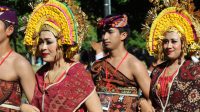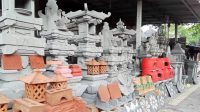- CANDI Bentar or split gate is entrance to a Balinese royal palace or temple compound
- Today, its function expands to be used in public area such as the entrance to office, office complex, hotel, tourist attraction and others
Candi Bentar is a building of Balinese traditional architecture that has a unique design. Literally, Candi Bentar is a gate in the form of two similar and congruent buildings but is symmetrical in a split mirror.
In other words, Candi Bentar or Balinese split gate is a building that divides the left and right sides of the entrance and does not have a connecting roof at the top.
Philosophical meaning
Balinese traditional buildings, including Candi Bentar, also have philosophical meanings. In addition to the technical guidelines of Asta Kosala Kosali, it also reflects the views of the Balinese people in maintaining the balance of the universe. The balance here is built between the human relationship with God, the relationship between humans, and humans and the surrounding environment.
From an artistic point of view, each part of the split gate is beautified with Balinese ornaments in the form of flora and fauna motifs. At the bottom, there is an elephant head ornament (karang asti), in the middle there is a flora ornament such as tendrils and at the top there is karang boma as mystical creatures, angels and the like. This ornament is not standard but optional. There are those who make in detail while some others make in raw design.
History
Historically, Candi Bentar in Bali was influenced by the culture of the Majapahit Kingdom in East Java. To enter or leave an area with the Candi Bentar, people will usually pass up and down several stairs.
In ancient times, the candi bentar in Bali was only used specifically for building the royal palace or castle. Candi Bentar is always placed in the outermost area which is the boundary between the inside of the building and the outside. Meanwhile, the houses of ordinary people in the past did not use the candi bentar.
Then, Candi Bentar is also used in sacred building areas such as temples. From the outermost area (Jaba Sisi) to enter the middle area (Jaba Tengah) the gate is in the form of Candi Bentar. From here, enter the innermost area (jeroan) of the main holy place, there is a gate in the form of a kori or roofed gate.
The artists who designed the Candi Bentar are the undagi, a Balinese traditional architect. Candi Bentar is often displayed in a sturdy and majestic design. Those who are experienced have the skills to design the right candi bentar in accordance with its function based on the Asta Kosala Kosali (Balinese geomancy) guidelines.
Current usage
In subsequent developments, Candi Bentar is also used in a wider context than pura and puri. It also introduces the nuances of traditional Balinese architecture to the wider community in the modern area.
For public areas, for example, Candi Bentar is now widely used for the gates of office, office centers, hotels or tourist areas. Thus, the general public also gets a sensation of the Balinese atmosphere that is presented outside the temples and castles.











